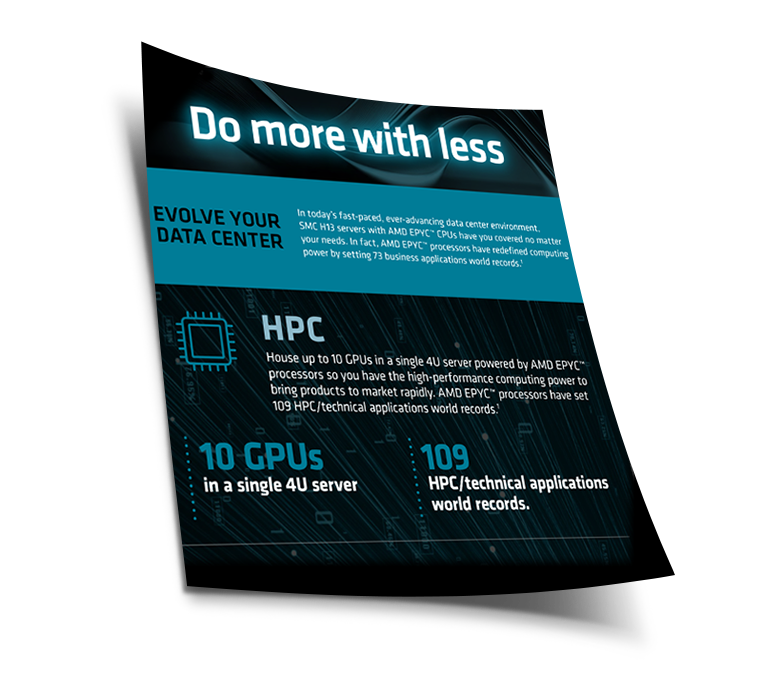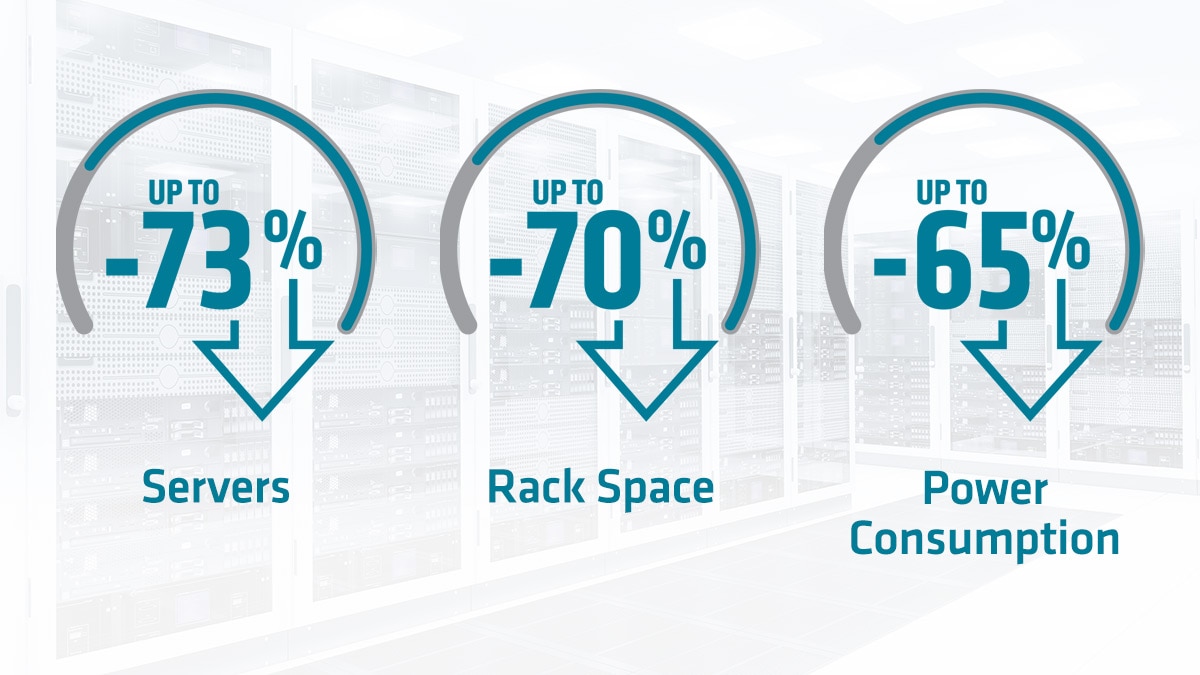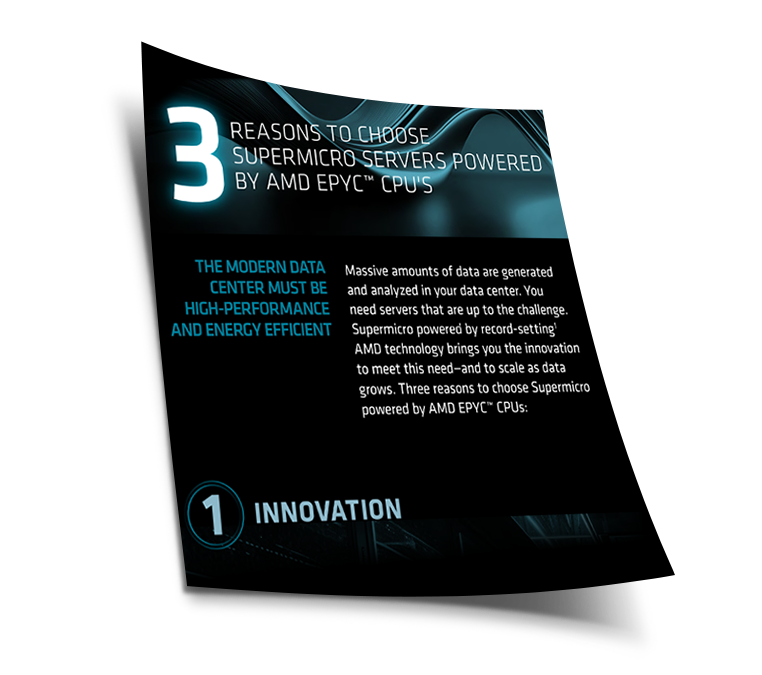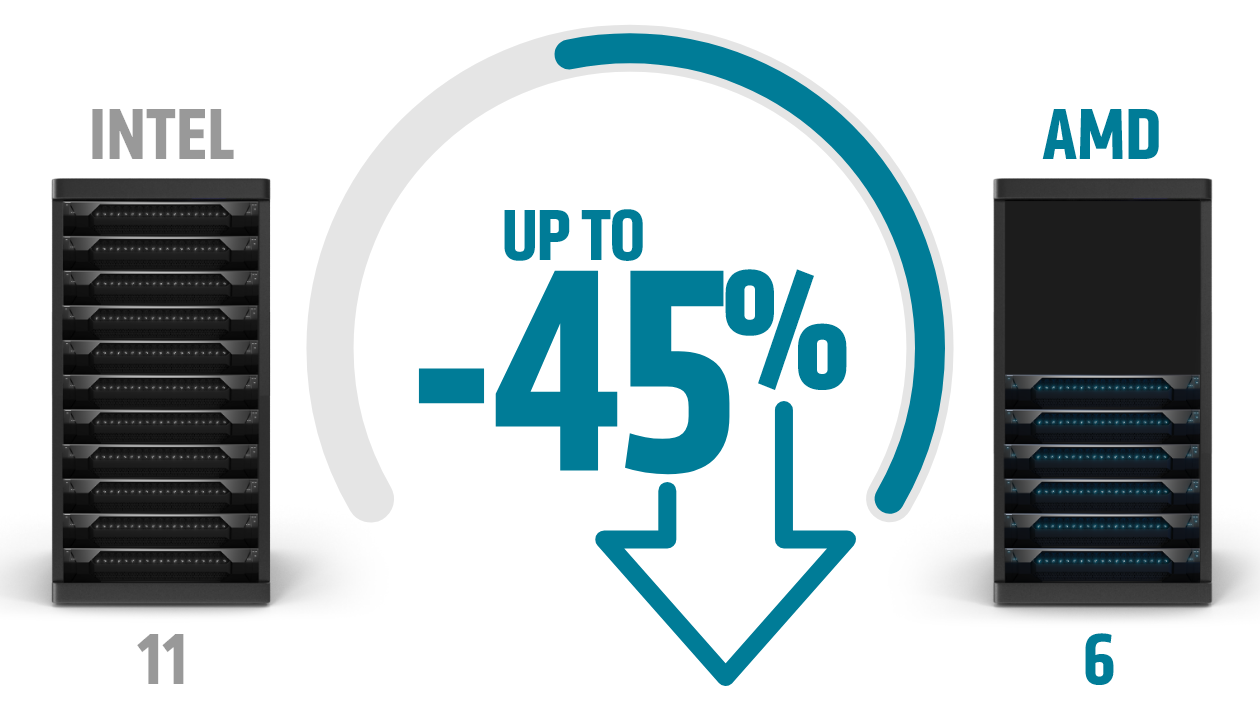
Choosing AMD can transform your data center and advance your business
AMD EPYC™ processors are the world’s best data center CPUs. They deliver the data center computing performance that enterprises require to meet customer demands, while optimizing rack footprint and energy efficiency, even when IT budgets are tightening.


Evolve Your Data Center
Learn why AMD powered Supermicro Servers are well suited for AI, Big Data Analytics (BDA), Cloud, HCI, and HPC workloads.

Contact an AMD Server Expert
Enable Strategic Initiatives via Consolidation
The growing demand for increased IT infrastructure, applications, and data center capacity can begin to strain the capabilities of existing data center infrastructure and limit the ability to deploy new strategic initiatives and services. Organizations faced with maximized data center footprints and power capacities can drastically consolidate rack space by replacing legacy servers with the latest servers powered by AMD EPYC processors. When upgrading from Intel Xeon Gold 6143 to 4th Gen AMD EPYC 9334, organizations can use up to 73% fewer servers, 70% fewer racks, and 65% less power to reach a SPECrate® integer score of at least 80,000.1



3 Reasons to Choose Supermicro Servers with AMD
Discover what makes AMD powered Supermicro Servers the ultimate solution for enterprise data centers.

Why Choose AMD EPYC
Selecting the right data center processor for your next server deployment can help IT organizations get more performance and density while maintaining or reducing their data center footprints.
For example, to reach a SPECrate® integer score of at least 10,000 would require 11 of the latest dual socket Intel Xeon Platinum 8490H based servers but only 6 dual socket AMD EPYC 9654 powered servers. With this consolidation, it is estimated capital expenditure could be reduced by up to 58% and annual operational cost by up to 46% over 3 years.2
Servers powered by 4th Gen AMD EPYC processors can help you:
- Run the same workloads with fewer servers
- Reduce operational and energy costs
- Free up precious data center space and power and allocate this capacity for new workloads and services
Footnotes
- SP5TCO-055: In a server refresh scenario with a 2P AMD EPYC 32 core 9334 CPU powered server solution replacing a 5 1/2 -year old Intel 2P server based on the 16 core Intel Xeon Gold 6143 CPU based server solution; to deliver 80,000 units of integer performance, the AMD EPYC 9334 CPU takes an estimated: 296 fewer servers (111 AMD servers vs 407 Intel servers) and 5,920 fewer cores and 70% less space (AMD 6 rack vs Intel 20 rack); with a $2.5 million or 62% lower 3-yr TCO than the legacy Intel based server solution TCO. The new AMD solution TCO is comprised of the server cost (CapEx) and the power (OpEx). The legacy Intel solution TCO consists of OpEx only (the extended warranty cost and power). Over the 3-years of this analysis, the AMD powered server uses 65% less power with an estimated cost of $284,054 vs the Intel based server power cost of $822,797, using a PUE of 1.7, saving $538,743 over the 3 years of this analysis with an estimated US power cost of $0.128 / kWh. The 2P EPYC core CPU solution also provides estimated Greenhouse Gas Emission savings emissions avoided equivalent to 1,571 MTCO2e (1,731 US tons) over the 3 years of this analysis which is 577 US tons of CO2 annually and is the equivalent of the sequestration equivalent of 628 acres USA forest annually. For additional details, see https://www.amd.com/en/claims/epyc4#SP5TCO-055
- SP5TCO-032: This scenario contains many assumptions and estimates and, while based on AMD internal research and best approximations, should be considered an example for information purposes only, and not used as a basis for decision making over actual testing. The Bare Metal Server Greenhouse Gas Emissions TCO (total cost of ownership) Estimator Tool - version 6.80, compares the selected AMD EPYC™ and Intel® Xeon® CPU based server solutions required to deliver a TOTAL_PERFORMANCE of 10,000 units of integer performance based on the published scores for these specific Intel Xeon and AMD EPYC CPU based servers as of January 10, 2023. This estimation reflects a 3-year time frame with a PUE of 1.7 and a power US power cost of $0.16 / kWh. This analysis compares a 2P AMD 96 core AMD EPYC_9654 powered server with a SPECrate2017_int_base score of 1790, https://spec.org/cpu2017/results/res2022q4/cpu2017-20221024-32607.pdf; to a 2P Intel Xeon 60 core Platinum_8490H based server with a SPECrate2017_int_base score of 991, https://spec.org/cpu2017/results/res2023q1/cpu2017-20221206-33039.pdf.
Environmental impact estimates made leveraging this data, using the Country / Region specific electricity factors from the '2020 Grid Electricity Emissions Factors v1.4 – September 2020', and the United States Environmental Protection Agency 'Greenhouse Gas Equivalencies Calculator'. For additional details, see https://www.amd.com/en/claims/epyc4#SP5TCO-032.
- SP5TCO-055: In a server refresh scenario with a 2P AMD EPYC 32 core 9334 CPU powered server solution replacing a 5 1/2 -year old Intel 2P server based on the 16 core Intel Xeon Gold 6143 CPU based server solution; to deliver 80,000 units of integer performance, the AMD EPYC 9334 CPU takes an estimated: 296 fewer servers (111 AMD servers vs 407 Intel servers) and 5,920 fewer cores and 70% less space (AMD 6 rack vs Intel 20 rack); with a $2.5 million or 62% lower 3-yr TCO than the legacy Intel based server solution TCO. The new AMD solution TCO is comprised of the server cost (CapEx) and the power (OpEx). The legacy Intel solution TCO consists of OpEx only (the extended warranty cost and power). Over the 3-years of this analysis, the AMD powered server uses 65% less power with an estimated cost of $284,054 vs the Intel based server power cost of $822,797, using a PUE of 1.7, saving $538,743 over the 3 years of this analysis with an estimated US power cost of $0.128 / kWh. The 2P EPYC core CPU solution also provides estimated Greenhouse Gas Emission savings emissions avoided equivalent to 1,571 MTCO2e (1,731 US tons) over the 3 years of this analysis which is 577 US tons of CO2 annually and is the equivalent of the sequestration equivalent of 628 acres USA forest annually. For additional details, see https://www.amd.com/en/claims/epyc4#SP5TCO-055
- SP5TCO-032: This scenario contains many assumptions and estimates and, while based on AMD internal research and best approximations, should be considered an example for information purposes only, and not used as a basis for decision making over actual testing. The Bare Metal Server Greenhouse Gas Emissions TCO (total cost of ownership) Estimator Tool - version 6.80, compares the selected AMD EPYC™ and Intel® Xeon® CPU based server solutions required to deliver a TOTAL_PERFORMANCE of 10,000 units of integer performance based on the published scores for these specific Intel Xeon and AMD EPYC CPU based servers as of January 10, 2023. This estimation reflects a 3-year time frame with a PUE of 1.7 and a power US power cost of $0.16 / kWh. This analysis compares a 2P AMD 96 core AMD EPYC_9654 powered server with a SPECrate2017_int_base score of 1790, https://spec.org/cpu2017/results/res2022q4/cpu2017-20221024-32607.pdf; to a 2P Intel Xeon 60 core Platinum_8490H based server with a SPECrate2017_int_base score of 991, https://spec.org/cpu2017/results/res2023q1/cpu2017-20221206-33039.pdf.
Environmental impact estimates made leveraging this data, using the Country / Region specific electricity factors from the '2020 Grid Electricity Emissions Factors v1.4 – September 2020', and the United States Environmental Protection Agency 'Greenhouse Gas Equivalencies Calculator'. For additional details, see https://www.amd.com/en/claims/epyc4#SP5TCO-032.



